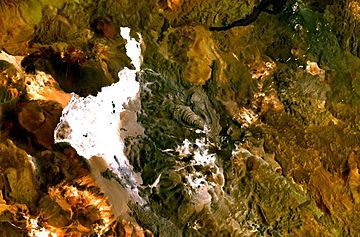Cerro Bayo Complex facts for kids
Quick facts for kids Cerro Bayo |
|
|---|---|

The Cerro Bayo volcanic complex lies along the Chile-Argentina border east of the Salar de Gorbea, the light-colored area at the left-center portion of this NASA Landsat image. A young well-preserved crater can be seen NE of an older snow-covered center (bottom-center). A younger northern center along the national border has a well-preserved 400-m-wide crater.
|
|
| Highest point | |
| Elevation | 5,401 m (17,720 ft) |
| Geography | |
| Location | Argentina-Chile |
| Parent range | Andes |
| Geology | |
| Mountain type | Complex volcano |
| Last eruption | Unknown |
Cerro Bayo is a large volcano located right on the border between Argentina and Chile. It's not just one simple volcano, but a group of four volcanoes that overlap each other, forming a complex volcano. These volcanoes are lined up from north to south.
The main part of Cerro Bayo is on the Argentine side. However, the very top, or summit, of this volcano group is actually a bit west of the border, in Chile. This huge volcano is quite old, about 800,000 years old! It's also connected to a process called "ground uplift," where the land slowly pushes upwards. This uplift also affects other nearby volcanoes like Lastarria.
What is Cerro Bayo?
Cerro Bayo is a type of volcano known as a stratovolcano. This means it's a tall, cone-shaped volcano built up by many layers of hardened lava, ash, and rocks. The summit of Cerro Bayo is very high, reaching 5,401 meters (about 17,720 feet) above sea level.
From its peak, two thick lava flows once poured out. These flows were made of a type of lava called dacite, which is very sticky. They traveled towards the north and left behind noticeable ridges on the ground.
Unique Features of Cerro Bayo
You can find sulfur at Cerro Bayo. It appears in large deposits and also in old "fumarole chimneys." Fumaroles are vents in the Earth's surface that release steam and gases, often smelling like sulfur.
The volcano formed in three main stages, each producing different lava flows. Some of the oldest rocks found here are about 1.6 million years old. The youngest rocks are much newer, around 23,000 years old. In winter, the volcano can be covered in snow, just like many high mountains.
In 2007, scientists studying nearby salt flats saw a steam eruption from Cerro Bayo. This means the volcano released steam and gas, showing it's still active in some way, even if it hasn't had a big lava eruption recently.
See also
 In Spanish: Complejo Cerro Bayo para niños
In Spanish: Complejo Cerro Bayo para niños
- List of volcanoes in Chile
- List of volcanoes in Argentina
- List of mountains in the Andes
- Los Colorados (caldera)

